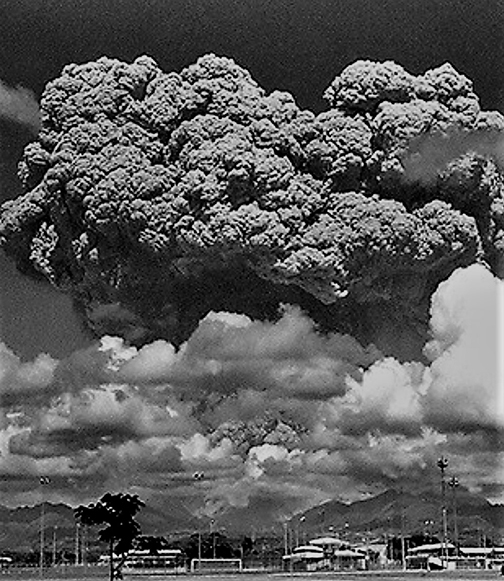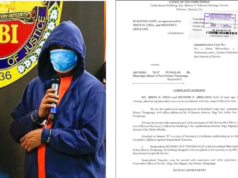ONCE WAKEN, Mount Pinatubo gave vent to centuries of pent-up fury with a series of powerful eruptions, the biggest of which spewed a deadly cloud of ash and gases 25 kilometers into the sky on June 13.
“That is already the big bang. I can’t see any other eruption that will exceed this. What we are seeing now are phenomenal eruptions,” Director Raymundo S. Punongbayan of the Philippine Institute of Volcanology and Seismology reported.
He cautioned though that: “The story of Mount Pinatubo is not quite over yet.” Mount Pinatubo proved Punongbayan wrong – on the first assertion, and right – on the caution.
June 14 saw the dark clouds like the wings of a monstrous bird casting trembling shadows across Angeles City during the day and a strange gloomy spell that dimmed the lights of the city’s tourist district in Balibago.
Residents, confused as to the real danger became expectant of a distant calamity. Frightened by the frequency of mild quakes and the smell of sulfur in the air, they braced themselves for the inevitable.
The people with foresight started to leave; the fearful began long prayers at home and inside churches; the ignorant, as usual the powerless, waited in trepidation, ready to accept anything, even danger and destruction in sordid acceptance.
That was how the Mount Pinatubo eruption of June 15, 1991 came to Pampanga: with deathly fear, unfathomable anxiety, and widespread confusion that only plagues, war and the other scourges of the Four Horsemen of the Apocalypse could have wreaked anywhere.
Like an epic, graphic accounts of the Great Eruption varied in their dramatic and incredible description. Real life narrations and first-hand experiences of those who remembered the event are reinvented in every retelling.
Newspapers of the day were unanimous on the congruent conclusion that the volcano had awakened from a 600- year slumber, with accurate forecast of vast devastation, widespread socio-economic dislocation, and a heavy toll from the volcanic fury.
At the Zambales side was a group of media workers who quoted witnesses who said the skies darkened momentarily after the volcano erupted in the early morning of 15 June.
Newsmen reporting from Clark said Mount Pinatubo vomited scorching volcanic material in a violent outburst, then acrid ashes and gases oozed out of the volcano’s active vents. Like the explosion of the first atom bomb in Hiroshima which was timed officially by the US military, the Phivolcs placed the Great Eruption at 8:15 in the morning of 15 June 1991. And thereafter, day turned into the blackest of night.
A tropical storm spotted a distance away from Central Luzon as early as 10 June moved in for the “kill” after the major explosion and developed into a full-blown typhoon.
Thus, Typhoon Diding blew volcanic ash around Central Luzon. It spread and swirled the debris up to Metro Manila, and as far away as several countries that affected air travel for some time.
The midday darkness, the rumblings of the volcano, frightening quakes and aftershocks, lightning and thunder, howling winds and a torrential rain of pumice stones as big as golf balls, mud and ash did indeed presage an apocalyptic end of days.
Panic
Panic broke out in all the districts of Angeles City, its 180,000-populace caught in pandemonium.
Thousands of vehicles scampered out of the city carrying frightened families to San Fernando and nearby towns. The most opulent residents opted to seek safety in Metro Manila.
The families that stayed behind had no alternative places to make their sanctuary. Those who panicked walked on foot or used every available transport to vacate their abodes in the city. Workers left their posts from factories, markets, shops, clinics, offices, and private occupations, to reach home as fast as they could to prepare for an evacuation. Even policemen on duty rushed home to secure their households.
Crying infants, mothers shouting instructions to members of the family, neighbors hollering for their straying children drowned out church bells that rang incessantly in warning and as notice to leave areas within the 30-kilometer radius from the spewing monster…
Phivolcs officials had earlier warned residents living within the danger zone to immediately abandon their places…
When the 1,500 US Air Force security unit who earlier declared they would abandon Clark “only when we see lava at our doorsteps” raced out of the abandoned base, Angeles residents knew it was time to do likewise.
Exodus
Thus, started the biggest exodus of evacuees and refugees that only a war could generate. All main thoroughfares leading out of Angeles, even those of San Fernando, were jammed with motorists.
Heavy pedestrian traffic clogged narrow roads with frightful people carrying and bundles of clothing. Infants nearly choked in the miasma of sulfuric fumes and steady ash. Every frightened Pampango thought it was the coming of doomsday.
At the North Luzon Expressway, traffic grounded to a standstill as thousands of men and women occupied all lanes in their rush to get out of Pinatubo’s way to wherever. “Kung saan kami maihahatid ng aming mga paa,” the refugees would say.
“We met wave upon wave of panic-stricken people. Kung saan sila pupunta, hindi nila alam,” said Quezon City Mayor Brigido Simeon Jr., a Kapampangan native. He brought some buses to help in the evacuation right at the Angeles City exit ramp of the expressway. The Amoranto Stadium and public and private school houses in Quezon City were designated evacuation centers.
Faces
Public places looked like an open sanitarium with people’s faces covered by surgical masks against ash inhalation. Acquaintances barely heard each other, their speech muffled by heavy gauze masks. But what need was there of distinct language when common fear and the reality of danger made for easy communications among the distraught victims?
In the Metro Clark areas, pumice stone pelted rooftops. A mud rain, then a mighty shower of ash fall covered the premier community as it did towns all over the province.
All through the day and night, sulfuric fumes engulfed Pampanga as pebbles kept falling in malevolent fury. Leaden ash and sand caused building to collapse, first the rooftops buckling down, then the whole structure keeling over like a boxer pummeled by knockout punches.
Two were killed and dozens of commuters were injured when the roof of the Philippine Rabbit Bus terminal in Angeles City collapsed due to heavy ashfall…
Mute agony
Thus, the day of terror began. The nighty ashfall turned day into night while earthquakes shook the region…Mute agony, unimaginable horror, and certain pain, had been written. And equally visible on both the faces of the rich and the poor.
As if to add force to nature’s punitive and merciless wrath, a powerful tropical storm appeared across Central Luzon. Its winds and rains unleashed millions of tons of pyroclastic materials from the slopes of the volcano, sending torrents of smoldering mudflows to Pampanga and Zambales lowlands, burying houses, scouring riverbanks, collapsing bridges, destroying roads, and causing massive destruction in infrastructure and private property unmatched even by the scourge of World War II.
Seven bridges in Pampanga, including the three main spans in Angeles City – Abacan, Friendship, and Pandan bridges – were destroyed by rampaging mudflows. Churches, markets, schools, public buildings, hospitals including the Ospital ning Angeles collapsed.
The Biggest Bang that was the June 15 eruption would segue to the succeeding blasts with more devastation to follow.
(From Chapter 3, The End of Days, of the book Pinatubo: Triumph of the Kapampangan Spirit edited by Bong Z. Lacson and published in 2008 by the San Fernando Heritage Foundation.)




